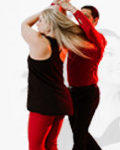The shoulder joint is one of the most complicated joints in the human body. During dancing, the shoulder is also a joint that is prone to injury. We’ve all heard stories about dancers with sore rotator cuffs (or worse), so it’s worth learning how to protect the shoulder while you dance.
In this drill, we’re going to focus on keeping the shoulder stable when the arm is extended. When your arm is extended out or up, it is really easy to let the shoulder become unsupported. This drill will help counter the tendency of letting the shoulder go when the arm is extended.
The Drill: On your own, lift your arm straight up as far as it can go. Your elbow should be close to your ear. Think of reaching the shoulder up to give yourself an extra inch or two.
Notice how your shoulder feels right now. This is the disconnected position: your shoulder is not supported by your back muscles, and as a result your shoulder joint is less stable. Because your shoulders are up, you also look less confident. So, this is the position we are training to avoid.

While your arm is still up, think of pulling your shoulders down the length of your back. As you do so, your elbow will naturally move away from your ear. Keep going until it feels like your shoulders are packed into the rest of your back. Notice how this position feels different from the shoulders-up position.

Now relax the arm. You are going to raise the arm by rotating the shoulder joint. Start with your arm by your side, and think of rotating your shoulder backwards. Let the arm be lifted in front of you until it goes overhead. As you rotate the shoulder and lift the arm, focus on where the shoulder connects with the back. Ensure that the shoulder remains packed through the entire process. (If you have pain or stiffness from a previous shoulder injury, don’t force the issue. Simply relax through that area and pack the shoulder again as soon as your range of movement will permit.)
Really focus on what your shoulder joint feels like right now. This feeling—with the shoulder connected to the back and supported all the way around—is what you want to replicate every time you move the arm.
Practice lifting your arms up and down while keeping the shoulder connected to the back. You will feel awkward at first; that’s normal. Once you have trained your body to find that position consistently, you will be able to hold the position without needing to contract your back muscles. Once that happens, you can start exploring your range of motion and it will feel much less constricted.




 Brian & Megan
Brian & Megan